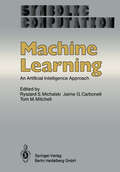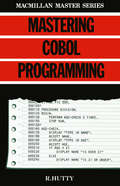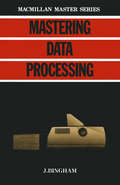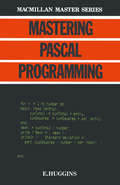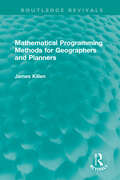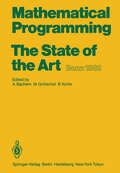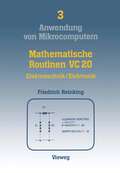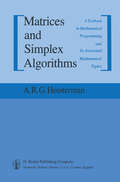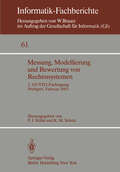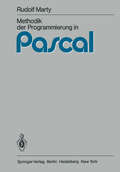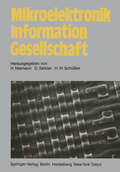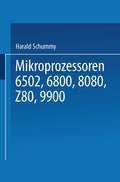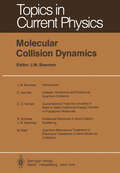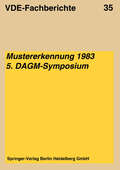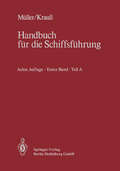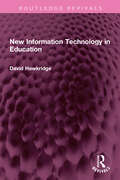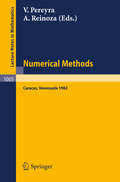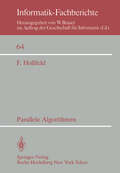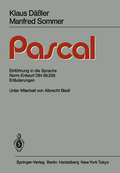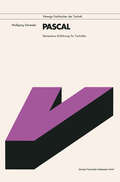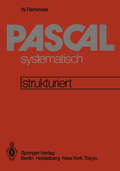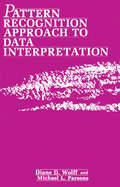- Table View
- List View
Machine Learning: An Artificial Intelligence Approach (Symbolic Computation)
by R. S. Michalski J. G. Carbonell T. M. MitchellThe ability to learn is one of the most fundamental attributes of intelligent behavior. Consequently, progress in the theory and computer modeling of learn ing processes is of great significance to fields concerned with understanding in telligence. Such fields include cognitive science, artificial intelligence, infor mation science, pattern recognition, psychology, education, epistemology, philosophy, and related disciplines. The recent observance of the silver anniversary of artificial intelligence has been heralded by a surge of interest in machine learning-both in building models of human learning and in understanding how machines might be endowed with the ability to learn. This renewed interest has spawned many new research projects and resulted in an increase in related scientific activities. In the summer of 1980, the First Machine Learning Workshop was held at Carnegie-Mellon University in Pittsburgh. In the same year, three consecutive issues of the Inter national Journal of Policy Analysis and Information Systems were specially devoted to machine learning (No. 2, 3 and 4, 1980). In the spring of 1981, a special issue of the SIGART Newsletter No. 76 reviewed current research projects in the field. . This book contains tutorial overviews and research papers representative of contemporary trends in the area of machine learning as viewed from an artificial intelligence perspective. As the first available text on this subject, it is intended to fulfill several needs.
Mastering Pascal Programming (Macmillan Master)
by Eric HugginsPascal is one of the newer programming languages, and is becoming more and more widely used in many applications. This is a complete course in Pascal-suitable for all syllabuses where practical knowledge of this computer language is required.
Mathematical Programming Methods for Geographers and Planners (Routledge Revivals)
by James KillenOriginally published in 1983, this was the first text to offer an in-depth treatment of mathematical programming methods explained from first principles. It considers all the major programming techniques and fully explains key terms, illustrates theories with detailed examples and shows how the various skills are applied in practice. It will be invaluable in both the academic world and to policy formulators and planners, who make extensive use of the methods described.
Mathematical Programming Methods for Geographers and Planners (Routledge Revivals)
by James KillenOriginally published in 1983, this was the first text to offer an in-depth treatment of mathematical programming methods explained from first principles. It considers all the major programming techniques and fully explains key terms, illustrates theories with detailed examples and shows how the various skills are applied in practice. It will be invaluable in both the academic world and to policy formulators and planners, who make extensive use of the methods described.
Mathematische Routinen VC 20: Elektrotechnik/Elektronik (Anwendung von Mikrocomputern)
by Ernst Friedrich ReinkingMatrices and Simplex Algorithms: A Textbook in Mathematical Programming and Its Associated Mathematical Topics
by Aaart R. HeestermanThis is a textbook devoted to mathematical programming algorithms and the mathematics needed to understand such algorithms. It was mainly written for economists, but the mathematics itself obviously has relevance for other disciplines. It is a textbook as well a~ in parts, a contribution to new knowledge. There is, accordingly, a broad ordering of climbing sophistication, the earlier chapters being purely for the student, the later chapters being more specialist and containing some element of novelty on certain points. The book is edited in five parts. Part I deals with elementary matrix operations, matrix inversion, determinants, etc. Part II is mainly devoted to linear programming. As far as students' readability is concerned, these two parts are elementary undergraduate material. However, I would claim, in particular with respect to linear programming, that I do things more efficiently than the standard textbook approach has it. This refers mainly to the search for a feasible solution i.e. Chapter 9, and to upper and lower limits, i.e. Chapter 10. I have also argued that the standard textbook treatment of degeneracy misses a relevant problem, namely that of accuracy. In short, I would invite anyone who has the task of writing or designing an LP-code, to first acquaint himself with my ideas. viii INTRODUCTION Parts III and IV are concerned with nonlinear programming.
Messung, Modellierung und Bewertung von Rechensystemen: 2. GI/NTG-Fachtagung Stuttgart, 21.–23. Februar 1983 (Informatik-Fachberichte #61)
by P. J. Kühn K. M. SchulzMikroelektronik Information Gesellschaft (Informationstechnik und Datenverarbeitung)
by H. Niemann D. Seitzer H. W. SchüsslerMikroprozessoren: 6502, 6800, 8080, Z 80, 9900 Grundlagen — Programmierung — Vergleiche — Übungen
by Harald SchumnyMolecular Collision Dynamics (Topics in Current Physics #33)
by M. BaerThis monograph covers a broad spectrum of topics in the very broad field of gas phase molecular collision dynamics. The Introduction previews each of the four fol lowing topics and attempts to sew them together with a common thread. In addition, a brief review of quantum reactive scattering is given there along with some gen eral remarks which highlight the difficulties in doing quantum reactive scatter ing calculations. The chapters are all written by theoreticians who are, of course, experts in the subjects they have written about. Three chapters, the ones by Secrest, Schatz, and the one by Schinke and Bowman deal with non-reactive atom-molecule scattering. Col lectively, they describe nearly the full breadth of scattering methods in use to day, from fully quantum mechanical to semiclassical and quasiclassical. The chapter by Baer is the only one dealing with quantum reactive scattering with the additional complexity of the coupling of two potential energy surfaces. The one simplifying feature of the treatment is that the reaction is constrained to be collinear. Overall, this monograph is mainly a review of the recent advances in the field of molecular collision dynamics, with, however, a considerable amount of new material. It is hoped that workers and students in the field will find reading the mono graph both enlightening and enjoyable.
Mustererkennung 1983: Vorträge des 5. DAGM-Symposiums vom 11.–13. Oktober 1983 in Karlsruhe
by H. KazmierczakNavigation: Teil A Richtlinien für den Schiffsdienst, Gestalt der Erde, Seekarten und nautische Bücher, terrestrische Navigation, Wetterkunde (Handbuch für die Schiffsführung #1 / A)
by J. H. Cepok C. Marcus G. OlbrückNew Information Technology in Education (Routledge Revivals)
by David HawkridgeFirst published in 1983, New Information Technology in Education surveyed developments in the field of information technology and demonstrated how it could be used to improve the quality of education. The book considered the experience of a wide range of countries, including the United States, Japan and those in Europe. While explaining the potential improvements that the new technology could bring, this book also reviewed the problem areas and helped educationalists to evaluate the relevance of the new technology for their own work. In an age of teaching via Zoom videos, it is interesting to take a look at a time when information technology in education was at its nascent stage. This book will be of interest to teachers and students of history, education, technology and pedagogy.
New Information Technology in Education (Routledge Revivals #32)
by David HawkridgeFirst published in 1983, New Information Technology in Education surveyed developments in the field of information technology and demonstrated how it could be used to improve the quality of education. The book considered the experience of a wide range of countries, including the United States, Japan and those in Europe. While explaining the potential improvements that the new technology could bring, this book also reviewed the problem areas and helped educationalists to evaluate the relevance of the new technology for their own work. In an age of teaching via Zoom videos, it is interesting to take a look at a time when information technology in education was at its nascent stage. This book will be of interest to teachers and students of history, education, technology and pedagogy.
Numerical Methods: Proceedings of the International Workshop Held at Caracas, June 14-18, 1982 (Lecture Notes in Mathematics #1005)
by V. Pereyra A. Reinozaa
Parallele Algorithmen (Informatik-Fachberichte #64)
by F. HossfeldZu den allgemeinen Einordnungen von Algorithmen ist in den letzten Jahren eine neue Klassifikation wichtig geworden: parallel versus sequentiell. Die Ursache findet sich in der nicht zuletzt durch die Entwicklungen der Halbleitertechnologie, vor allem aber durch den wachsenden Druck von Anwendungen, die höchste Rechnerleistung erfordern, erhöhten Bedeutung von Parallelprozessorarchitekturen. Das zunehmende Interesse an Parallelrechnern hat die Entwick lung von parallelen Algorithmen zur Lösung vielfältiger Problemstellungen beschleunigt. Eine Darstellung von Grundprinzipien, Entwurfsmöglichkeiten und Realisierungen paralleler Algorith men, die das Leistungspotential innovativer Rechnerarchitekturen erschließen, erscheint für die integrale Betrachtung der Thematik des "Parallel Computing" nicht nur notwendig, sondern auch - vor allem auf die deutschsprachige Fachliteratur bezogen - überfällig. Dem vorliegenden Band liegt das Skriptum -einer Spezial vorlesung gleichen Titels zugrunde, die ich im Sommersemester 1980 an der Universität Dortmund auf Einladung der Abteilung Informatik gehalten habe. Es ist nicht das Ziel, eine möglichst vollständige Sammlung der in den Zweigen dieses expansiven Forschungsgebietes bisher entwickelten parallelen Algorithmen zu liefern; vielmehr sollen mit dieser Annäherung an eine erste Gesamtdarstellung der Themati- insbesondere auch durch die Gegenüberstellung von repräsentativen sequentiellen Algorithmen - Charakteristika originärer paralleler Algorithmen aufgezeigt und ihr Bezug zu den Architektur elementen von Parallelprozessoren verdeutlicht werden. Dadurch soll auch hierzulande das Interesse an dieser immer wichtiger werdenden Fragestellung weiter gefördert und der Einstieg in die junge, über ein breites Spektrum von hauptsächlich englischsprachigen Fachzeitschriften verstreute Originalliteratur erleichtert werden; wegen der angelsächsischen Dominanz auf diesem Gebiet lassen sich dabei für die klare Begriffsbestimmung naturgemäß gewisse Anglizismen nicht vermeiden.
Pattern Recognition Approach to Data Interpretation
by Diane WolffAn attempt is made in this book to give scientists a detailed working knowledge of the powerful mathematical tools available to aid in data interpretation, especially when con fronted with large data sets incorporating many parameters. A minimal amount of com puter knowledge is necessary for successful applications, and we have tried conscien tiously to provide this in the appropriate sections and references. Scientific data are now being produced at rates not believed possible ten years ago. A major goal in any sci entific investigation should be to obtain a critical evaluation of the data generated in a set of experiments in order to extract whatever useful scientific information may be present. Very often, the large number of measurements present in the data set does not make this an easy task. The goals of this book are thus fourfold. The first is to create a useful reference on the applications of these statistical pattern recognition methods to the sciences. The majority of our discussions center around the fields of chemistry, geology, environmen tal sciences, physics, and the biological and medical sciences. In Chapter IV a section is devoted to each of these fields. Since the applications of pattern recognition tech niques are essentially unlimited, restricted only by the outer limitations of.
